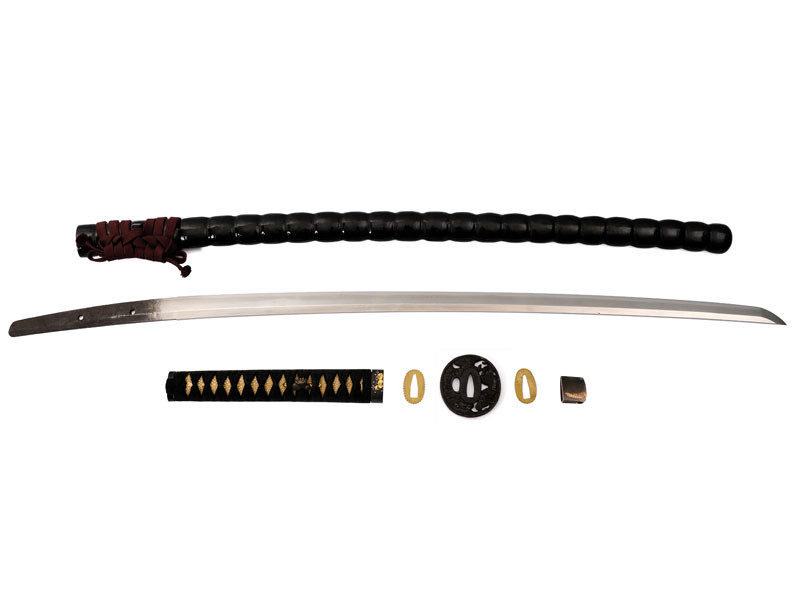














More informations about this product
| Total Weight | 1. 104 kg | |
| Weight without Saya | 0.902 kg | |
| Blade Weight | 0.616 kg | |
| Full length Naked Blade (Toshin) |
89.4 cm | |
| Nagasa | 69.9 cm | |
| Tsuka Length | 23.8 cm ( Nakago 19.5 cm) | |
| Sori (curvature) | 1.31 cm | |
| Kissaki Length | 3.10 cm | |
| Moto Haba | 2.85 cm | |
| Saki Haba | 1.91 cm | |
| Moto Kasane | A = 0.58 cm B = 0.62 cm |
|
| Saki Kasane | A = 0.40 cm B = 0.42 cm |
|
| Curvature | Koshi Zori Zori (Bizen Zori first third) | |
| Type Kissaki | Elongated Chū Kissaki ( Yamato influence) | |
| Blade Structure | Shinogi zukuri (diamond shape) with a high Shinogi | |
| Mune | Iori mune (Triangular) lowly elevated | |
| Hamon | Chū Suguha | |
| Hada | Itame / Masame / (few Mokume) with Chikei and Utsuri | |
| Boshi | Ko Maru with long Kaeri (Taki no Otoshi) | |
| Nakago | signed Masanobu (正信) on the Omote side. 2 Mekugi Ana, Kiri Yasurime (horizontal). Length 19.5cm, shape Futsu Gata (classical), end in Ha Agari Kurijiri (dissymetrical U) | |
| Saya | Weight 202g, length 76.9cm, ringed shiny black lacquer, Inro Kuroro, Silk Sageo colored Azuki. | |
| Tsuka & Tosogu (Tsuba, Menuki, Fuchi Kashira) |
- Tsuka: 3.76cm length, 136g weight, White Same, Tsumami Maki wrapping in black silk, Kashira in horn under the outside crossed braiding. Menuki in shape of a seashell ( Horagai / Conch), Fuchi Kashira with a design of wil ginger (葵- Aoi). - Tsuba: 118g weight external dimensions: 6.8cm x 7.05cm x 0,58cm signed "Hikone Jue Saten", Marugata (rounded shape), Sukashi, design of a horseman in the waves. -Habaki: 20g copper Habaki light horizontal Yasurime (nearly Muji) - Seppa: 2 seppa (2x4g) in gilded copper. |
|
| Study & Team Review |
Study:
The Bingo Mihara branch originates in the Yamato tradition. The Mihara school 三原派 stem when some Yamato smiths settled in the Bingo province.The founder of the Mihara school is Masaiye, 正家 6th generation, during the Tokuji era (1306-1308) at the end of the Kamakura era. One should notice that there are also some trails of a smith name Asaiye, but during the Tenpyō era (729-749). It is said that the Masaiye from the end of Kamakura, and founder of the Mihara, is in fact the renew of this former extinguished branch. There's 3 periods in the evolution of the Mihara school: until the Oei era (1394) it is the "Ko Mihara"; from Oei era to the Eikyo era (1429) it's known as the "Chū Mihara", and further on it's named the "Sue Mihara". The productions from the "Ko Mihara" are a very high end quality and historically significant, many being awarded, although being Mumei (not signed) the NBTHK Juyo Token Certificate. The Kinashi 木梨, Sue mihara 末三原, Hokke 法華, Tatubo 辰房, Goami 五阿弥, Kai 貝, Tomo 鞆 and Goami 其阿弥 schools are all afiiliated to this Mihara branch. These schools were located in the nowadays Onomichi district, part of the Hiroshima prefecture, where the ancient Bingo province was located. One of the particularity of the Mihara school is its 'conservative' side, with the often sober anc classical quenching lines.as the Suguha (straight quenching line), which denote frome the other productions of the Bizen province, where most of the other smiths have flamboyant quenching lines like in the Ichimonji school. This blade here comes from the "Kai" group, located in the Mihara town. This town is known for the ruins of its castle founded in the 16th century, Mihara-Jo, nicknamed "The floating castle" (Ukishiro). The smith Masanobu (正信) was active during the Tensho era (1573-1592) in the Bingo province for the Kai Mihara group. The steel of this blade is very similar to the productions of the Bitchu Aoe branch. The hamon is made of Ko-Nie and Nioi Deki. This another typical technical point the Koto/ Muromachi blade, The Shirake Utsui is perceptible in the Ji. |
|
Share your opinion
error Your review appreciation cannot be sent
feedback Report comment
check_circle Report sent
error Your report cannot be sent